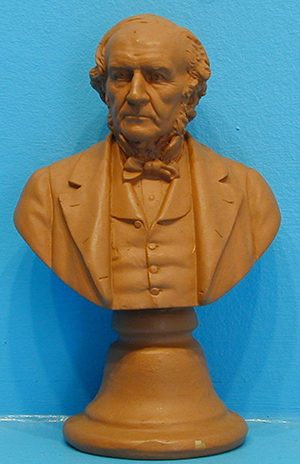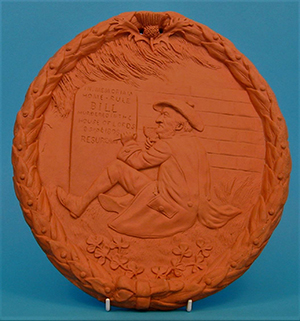Gladstone gone to pot
Published in Artefacts, Issue 1 (January/February 2020), Volume 28By John Stocks Powell

Above: Gladstone on a pedestal (17cm) by A. Bruce Joy, 1884, and produced by the Watcombe Terra Cotta Company, St Mary’s, south Devon.
Lenin with his arm outstretched, a never-aging Ceaușescu on placards in Bucharest—the images of leaders, potentates and celebrities have been with us for a long time, in film, photograph, stone, steel and ceramics. The ceramic form tended to the more domestic, certainly the more portable, and, rather than being imposed on the viewer from above, they were mostly chosen as private marks of support and respect.
Delftware in the seventeenth century sometimes displayed a king’s portrait and initials, but the main period for this material really began in the nineteenth century. Nelson did not just appear on pillars but also on pottery jugs for the mantelshelf; flat-back Staffordshire figures could feature Queen Victoria or the French emperor, Napoleon III, on horseback.

Above: This piece of pottery was produced to mark the defeat of Gladstone’s second Home Rule bill in the House of Lords in February 1893.
Admired, respected, loved and, indeed, hated, one of the political figures metamorphosed into ceramic souvenirs was Prime Minister William Ewart Gladstone (1808–98), whose influence on Ireland was so significant. His early political career was a journey out of strict church-and-state Toryism into Free Trade, Liberalism and Home Rule—from right to left, it could be said, so different from the usual journeys of politicians. He presented two Home Rule bills to parliament, in April 1886 and in February 1893; the second bill passed the House of Commons but was defeated in the House of Lords. To mark this defeat, this unmarked piece of pottery was produced. Gladstone is portrayed in his ‘Midlothian’ image (representing his parliamentary constituency) with the Scottish thistle above, but is seated on a bank garnished with shamrocks, carving a gravestone: ‘IN MEMORIAM, HOME RULE BILL MURDERED IN THE HOUSE OF LORDS 8 Sept 1893 RESURGAM’.
Gladstone was represented in many ceramic forms. For his detractors, there would be the oft-used device of a transfer portrait print fired in the bottom of a chamber-pot, but for many Gladstone was the ‘People’s William’. Busts were retailed.
John Stocks Powell was formerly librarian at York Minster Library.


















